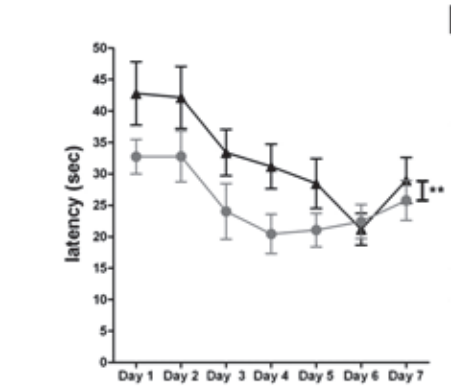Manipulating memory in the hippocampus by controlling production of a protein
June 5, 2013

Overexpression in the hippocampus dentate gyrus of mice resulted in significantly delayed spatial learning and memory as measured by longer latency to reaching the platform (upper plot) compared to control group (lower plot). (Credit: Boaz Barak et al./NeuroMolecular Medicine)
In the brain, cell-to-cell communication is dependent on neurotransmitters, chemicals that aid the transfer of information between neurons.
Several proteins have the ability to modify the production of these chemicals by either increasing or decreasing their amount, or promoting or preventing their secretion. One example is tomosyn, which hinders the secretion of neurotransmitters when in abnormal amounts.
Dr. Boaz Barak of Tel Aviv University‘s Sagol School of Neuroscience, in collaboration with Prof. Uri Ashery, used a method for modifying the levels of this protein in the mouse hippocampus — the region of the brain associated with learning and memory.
They found tomosyn had a significant impact on the brain’s activity: Over-production led to a sharp decline in the ability to learn and memorize information, the researchers reported in the journal NeuroMolecular Medicine.
“This study demonstrates that it is possible to manipulate various processes and neural circuits in the brain,” says Dr. Barak, a finding which may aid in the development of therapeutic procedures for epilepsy and neurodegenerative diseases such as Alzheimer’s.
Slowing the transmission rate of information when the brain is overactive during epileptic seizures could have a beneficial effect, and readjusting the levels of tomosyn in an Alzheimer’s patient may help increase cognition and combat memory loss, he said.
A maze of memory loss
The researchers teamed up with a laboratory at the National Institutes of Health (NIH) in Baltimore to create a virus that produces the tomosyn protein. In the lab, the virus was injected into the hippocampus region in mice. Then, to test the consequences, they performed a series of behavioral tests designed to measure functions like memory, cognitive ability, and motor skills.
In one experiment, called the Morris Water Maze, mice had to learn to navigate to, and remember, the location of a hidden platform placed inside a pool with opaque water. During the first five days of testing, researchers found that the test group with an over-production of tomosyn had a significant problem in learning and memorizing the location of the platform, compared to a control group that received a placebo injection.
And when the platform was removed from the maze, the test group spent less time swimming around the area where the platform once was, indicating that they had no memory of its existence. In comparison, the control group of mice searched for the missing platform in its previous location for two or even three days after its removal, notes Dr. Barak.
These findings were further verified by measuring electrical activity in the brains of both the test group and the control group. In the test group, researchers found decreased levels of transmissions between neurons in the hippocampus, a physiological finding that may explain the results of the behavioral tests.
Correcting neuronal processes by modifying brain proteins
In the future, Dr. Barak believes that the ability to modify proteins directly in the brain will allow for more control over brain activities and the correction of neurodegenerative processes, such as providing stricter regulation in neuronal activity for epileptic patients or stimulating neurotransmitters to help with learning and memory loss in Alzheimer’s patients.
A separate study conducted by the researchers supports that premise. It demonstrates that mouse models for Alzheimer’s disease do have an over-production of tomosyn in the hippocampus region, so countering the production of this protein could have a beneficial effect.
Now Dr. Barak and Prof. Ashery are developing a method for artificially decreasing levels of the protein. “We hypothesize that with an under-production in tomosyn, the mice will show a marked improvement in their cognitive performance in behavioral testing,” he said